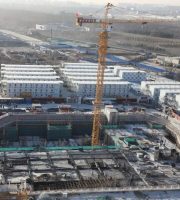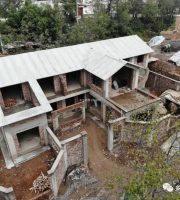Scaffolding is a temporary facility that plays a particularly important role in construction and installation. Scaffolding is required for concrete structure pouring, brick wall masonry, decoration and painting, pipeline installation, equipment installation, etc. It is one of the essential tools for successfully completing the construction tasks of power construction and installation projects. The appropriateness of selection and use not only affects the smooth progress and safety guarantee of construction operations, but also relates to the improvement of engineering quality, construction progress, and economic benefits..
According to their purposes, they are divided into masonry scaffolding, decoration scaffolding, installation scaffolding, and formwork support brackets;.
According to material, there are wooden scaffolding, bamboo scaffolding, and metal scaffolding; According to the structural form, scaffolding can be divided into pole type, frame group type (gantry), bridge type, suspended type, hanging type, cantilever type, and other tool type scaffolding; According to the number of rows of upright scaffolding, it is divided into single row scaffolding, double row scaffolding, and full bore scaffolding..
Scaffold consists of base plate, base, upright, large and small cross bars, slant support, throw bracing, diagonal bracing, wall connecting rod, bottom sweeping rod and its accessories. Its main functions are introduced as follows:.
1. Vertical poles (also known as pillars, standing poles, sky poles, vertical poles, etc.): perpendicular to the ground, they are the main load-bearing members of scaffolding. Its function is to transfer all the loads on the scaffold board to the foundation through the base and cushion plate..
2. Large horizontal bars (also known as water bars, longitudinal horizontal bars, tie bars, etc.): parallel to the wall. Its function is to connect with the upright pole as a whole, transferring all the load on the scaffold board to the upright pole..
3. Small crossbar (also known as crossbar, crossbar, horizontal bar, six foot bar, or row of wood): perpendicular to the wall, its function is to directly bear the load on the scaffold board and transfer this part of the load to the large crossbar. In double row scaffolding, it is an important member that connects the inner and outer rows of scaffolding, enhancing the overall stability of the scaffolding..
4. Slant support (also known as diagonal bracing and splayed bracing): closely connected with the upright tube outside the scaffold, obliquely crossed with the upright tube and formed an angle of 45 ° -60 ° with the ground, and set up continuously from top to bottom, forming a “zigzag” shape. Mainly set at the corner of the scaffold, its function is to prevent the scaffold from tilting along the longitudinal direction and bearing the horizontal force of the scaffold..
5. Scissor braces (also known as cross braces or cross covers): Double diagonal braces set on the outside of a scaffold, intersecting with each other, forming a 45 ° -60 ° angle with the ground. The function is to connect the scaffold as a whole and withstand the horizontal force of the scaffold, enhancing the overall stability of the scaffold..
6. Throwing support (also known as support or railing): It is a diagonal rod set outside (around) the scaffold, supporting the scaffold from the ground. It is generally at a 60 ° angle with the ground, and its function is to increase the lateral stability of the scaffold, prevent it from tilting or tilting outward. Its function is particularly important in the early stage of supporting the scaffold and the last few steps of dismantling the scaffold. A horizontal support (also known as a horse beam or anti support) should be used to connect the throwing support to the scaffolding upright to enhance stability..
7. Wall connecting rod (also known as pull connection): It is a horizontal rod that is not more than 4 meters vertically and 7 meters horizontally along the vertical direction of the upright rod. It is set up to withstand tension and compression and is connected to the main structure. Its function is to bear all the wind loads of the scaffold and the loads generated by the uneven sinking of the inner and outer rows of upright rods..
8. Sweeping pole: It.



